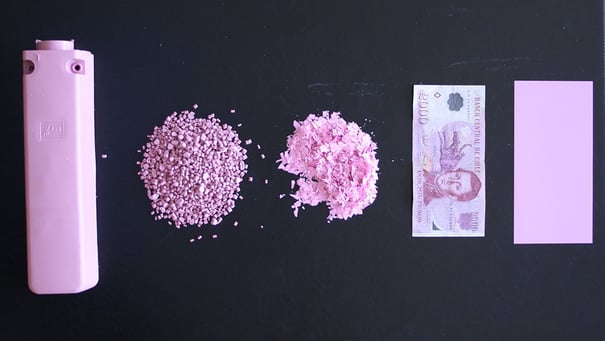Polymer banknotes are an ongoing innovation in currency. Instead of a cotton-based substrate, these notes are made of a thin sheet of polypropylene plastic. This new substrate changes several characteristics of the banknote. These include: Higher durability, additional security features and the ability to be recycled into plastic pellets. All of these elements ensure a longer and more secure lifetime. Close to 30 countries have already began adopting the banknotes for some of their denominations showing polymer to become increasingly popular.

Recyclability of polymer banknotes
One of the key features of polymer banknotes is the fact that after its long lifetime, the plastic material is also easy to recycle. The shredded polymer notes can be extruded and palletized at high temperature. This process melts the polymer and inks and mixes them in a homogenous blend. These pellets are then put in moulding to make new plastic items such as compost bins, flowerpots, power sockets and plumbing supplies.
Destroying cotton and polymer based banknotes simultaneously
During a country’s switch to polymer, the old cotton bank notes will also require processing. This is where shred extraction comes into play. One example of this is a project that Kusters did with the Bank of England. While newly printed notes in England are polymer based, the cotton notes remain legal tender for a certain period of time. While the majority of banknotes that are returned for destruction now consist of the old cotton notes, an increasing percentage will become polymer over time until 100% of the notes have been replaced with the polymer substrate. To cover this process, the bank required a solution to shred both types of notes simultaneously. In order to achieve this, Kusters upgraded their existing systems to handle both polymer and cotton. You can read more about this project in the case study below.
Shred extraction to recycle both subtrates
Naturally, changing cotton-based to polymer comes with new challenges. After shredding polymer or cotton notes, the recycling benefits of both substrates can be optimised by correctly transporting the two substrates to separate containers. Here, ductwork and switch valves allow you to process either substrate and have shred residue end in the correct container. This way, you ensure polymer and cotton is separately collected and can be reprocessed accordingly and in the most economic way.
While the thought that a power socket may be made of banknotes in the future is great, the facilities necessary to realise this might not yet be available everywhere. Since the notes cannot be incinerated due to air pollution, recycling methods can be limited depending on the local circumstances, making polymer adoption more difficult.
Are you interested in learning more about the possibilities of polymer banknote destruction? Or whether it is possible to upgrade your existing system? All our banknote destruction products are equipped to process both polymer and cotton banknotes, avoiding any issues with a change in substrate.


